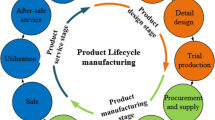Abstract
The assembly sequence plan (ASP) is a relatively new concept that has drawn the attention of many researchers over the last years. In spite of the enormous development of CAD Software in many aspects, the automatic generation of ASP from CAD assembly remains a subject to improve especially with the growing complexity of industrial products. This article presents an ASP generation approach based on CAD assembly data. To generate ASP, the developed method is composed of two mains steps. The first one is the extraction of the CAD assembly data. To identify all possible obstacles during the components’ displacement, an interference analysis process is performed in the second step. An illustrative example of the CAD assembly is detailed in the different stages of this article.
Similar content being viewed by others
References
Smith SSF (2004) Using multiple genetic operators to reduce premature convergence in genetic assembly planning. Comput Ind 54(1):35–49
de Homem MLS, Sanderson AC (1991) A correct and complete algorithm for the generation of mechanical assembly sequences. IEEE Trans Robot Autom 7:228–240
Dini G, Santochi M (1992) Automated sequencing and subassembly detection in assembly planning. Ann CIRP 41(1):1–4
Zhang YZ, Ni J, Lin ZQ, Lai XM (2002) Automated sequencing and sub-assembly detection in automobile body assembly planning. J Mater Process Technol 129(1):490–494
Niu X, Ding H, Xiong Y (2003) A hierarchical approach to generating precedence graphs for assembly planning. Int J Mach Tool Manuf 43(1):1473–1486
Tseng HE, Wang WP (2007) Using memetic algorithms with guided local search to solve assembly sequence planning. Expert Syst Appl 33:451–467
Hao W, Hongfu Z (2009) Using genetic/simulated annealing algorithm to solve disassembly sequence planning. J Syst Eng Electron 20(4):906–912
Su Q (2009) A hierarchical approach on assembly sequence planning and optimal sequences analyzing. Robot Comput Integr Manuf 25:224–234
Zha X, Du H (2002) A PDES/STEP-based model and system for concurrent integrated design and assembly planning. Comput Aided Des 34(14):1087–1110
Gottipolu RB, Ghosh K (2003) A simplified and efficient representation for evaluation and selection of assembly sequences. Comput Ind 50(3):251–264
Su Q (2007) Computer aided geometric feasible assembly sequence planning and optimizing. Int J Adv Manuf Technol 33:48–57
Mathew AT, Rao CSP (2010) A novel method of using API to generate liaison relationships from an assembly. J Softw Eng Appl 3:167–175
Ou LM, Xu X (2013) Relationship matrix based automatic assembly sequence generation from a CAD model. Comput Aided Des 45(1):1053–1067
Morato C, Kaipa KN, Gupta SK (2013) Improving assembly precedence constraint generation by utilizing motion planning and part interaction clusters. Comput Aided Des 45(1):1349–1364
Wilson RH, Latombe JC (1994) Geometric reasoning about mechanical assembly. Artif Intell 71(2):371–396
SolidWorks Corporation (2013) SolidWorks user’s manual
Author information
Authors and Affiliations
Corresponding author
Rights and permissions
About this article
Cite this article
Trigui, M., BenHadj, R. & Aifaoui, N. An interoperability CAD assembly sequence plan approach. Int J Adv Manuf Technol 79, 1465–1476 (2015). https://doi.org/10.1007/s00170-015-6855-2
Received:
Accepted:
Published:
Issue Date:
DOI: https://doi.org/10.1007/s00170-015-6855-2




